- Home
- Encyclopedia
- Wyoming’s Nuclear Might: Warren AFB In The Cold...
Wyoming’s Nuclear Might: Warren AFB in the Cold War
The history of nuclear weapons in Wyoming is intimately connected to the F. E. Warren Air Force Base, which in turn is tied to the global development of rocketry and nuclear might. If Wyoming were a nation, Warren AFB in Cheyenne would make it one of the world’s major nuclear powers. Its history with nuclear weapons in Wyoming is tied closely to the worldwide tensions of the Cold War, and with the development of missile-based nuclear weapons systems.
The base started out in life as Fort D.A. Russell in 1867. Fort Russell eventually grew into one of the country’s largest cavalry posts. In the late 19th century, it was the base for the famous Buffalo Soldiers of three African-American regiments: the 9th and 10th Cavalry, and the 24th Infantry.
In 1876, troops from Ft. Russell fought against the Sioux in the same war in which Gen. George A. Custer met his fate at the Little Big Horn. In 1901, troops from the fort served in the Philippines. And during the Mexican Revolution from 1913 to 1916, artillery units from the fort were stationed along the U.S.-Mexico border.
John “Black Jack” Pershing — then a captain, later the general of the armies in World War I — was stationed at Ft. Russell for a time. Pershing married the daughter of Wyoming’s U.S. Sen. Francis E. Warren, for whom the fort was later renamed. F.E. Warren AFB was transferred to the Air Force in 1947, and is the oldest continuously active base in that branch of the service. (Holland)
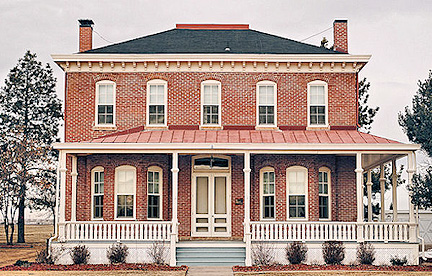
F.E. Warren Air Force base has no airplanes. It is, however, one of the largest missile-command bases in the nation.
During World War II, Germany unleashed the first missile assaults in history against England, with the infamous V-1 and V-2 rockets. While U.S. efforts to develop pilotless aircraft had lagged before that, the German success inspired intense new research, eventually producing about 5,000 JB-2s (JB for “jet bomb”). These weapons were not ready in time for deployment against Germany, but work continued on pilotless aircraft and, eventually, intercontinental ballistic missiles (ICBMs).
After the war, the federal government awarded a contract to Convair for a missile that could deliver a 5,000-pound warhead to within 5,000 feet of any target 1,500 to 5,000 miles away. That was a call for an enormous leap in distance and accuracy. The V-2’s range was only about 200 miles.
Weapons on missiles
Immediately after the explosion of the atomic bomb at Hiroshima, the U.S. armed services had suggested putting nuclear weapons on missiles. This proved extremely difficult to achieve, however. In November 1952, the U.S. achieved a breakthrough in thermonuclear research — the hydrogen bomb—that promised lighter, more powerful warheads. Missile weight could now be reduced, and the missiles did not have to be so accurate.
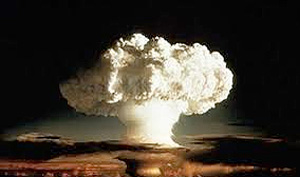
Missile and nuclear weapon development was given another boost in the mid- to late-1950s during the “missile gap” debate, when Democrats claimed — inaccurately, as it happened—that the Eisenhower administration had allowed the Soviet Union to develop a sizable advantage in ICBM numbers. In a speech on the U.S. Senate floor on August 14, 1958, Massachusetts Sen. John F. Kennedy argued that the Eisenhower administration had allowed U.S. defenses to deteriorate. “The most critical years of the gap,” Kennedy said in his speech, “would appear to be 1960-1964 … our military position today is measured in terms of gaps — missile gap, space gap, limited-war gap.” (Goodby)
In the case of missiles, at least, this concern was overstated. Instead of having thousands of functioning missiles, the Soviets actually only had four prototypes. The fear generated by these claims encouraged extensive spending and accelerated development of missiles and nuclear weapons, feeding the nuclear arms race.
Missile and weapons development together surmounted a number of technical, bureaucratic and military hurdles throughout the 1950s. The Air Force won the bureaucratic battles to command the ballistic missile squadrons. Two ICBMs — Atlas and Titan — were deployed. In August 1957, the Air Force selected Warren Air Force Base as the first Atlas operational base, and Lowry Air Force Base in Colorado as the first Titan site.
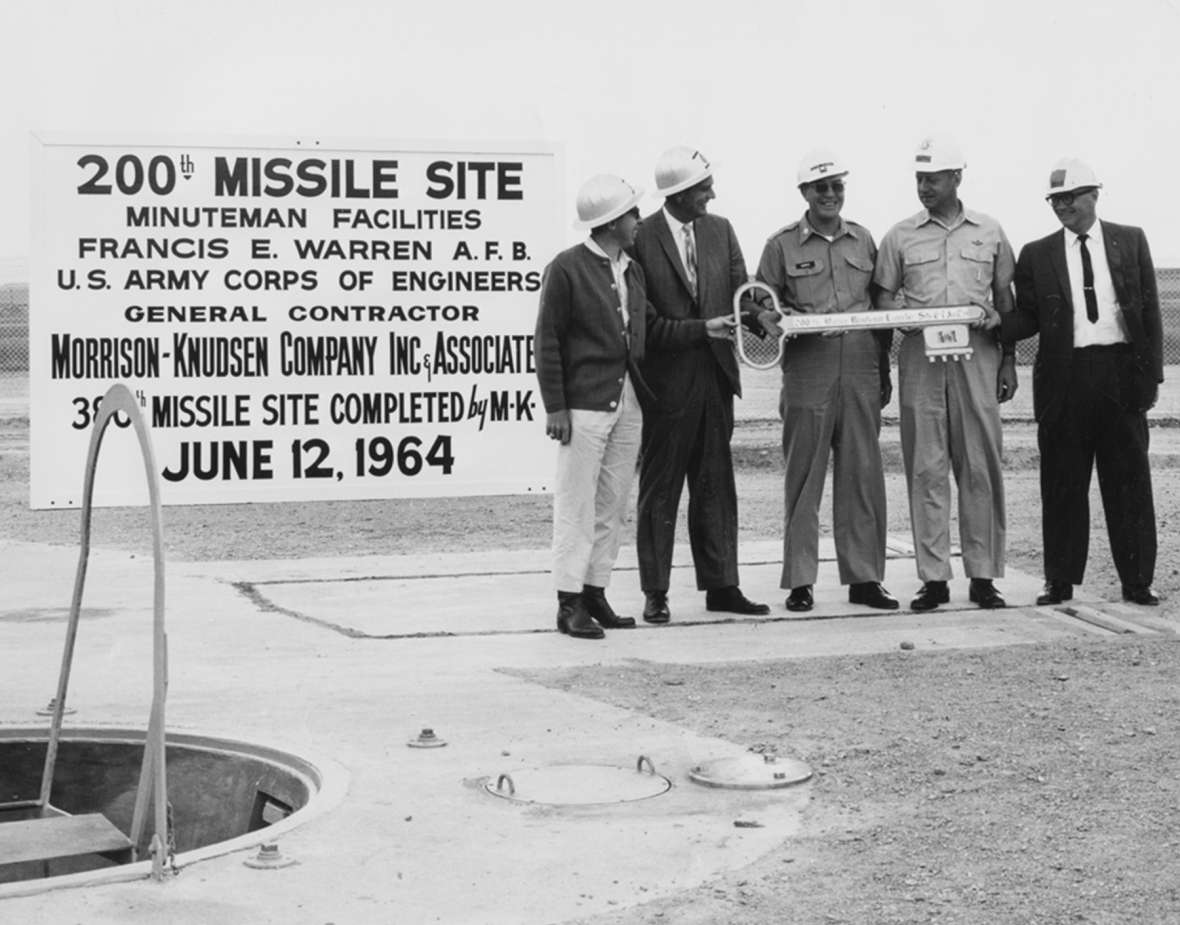
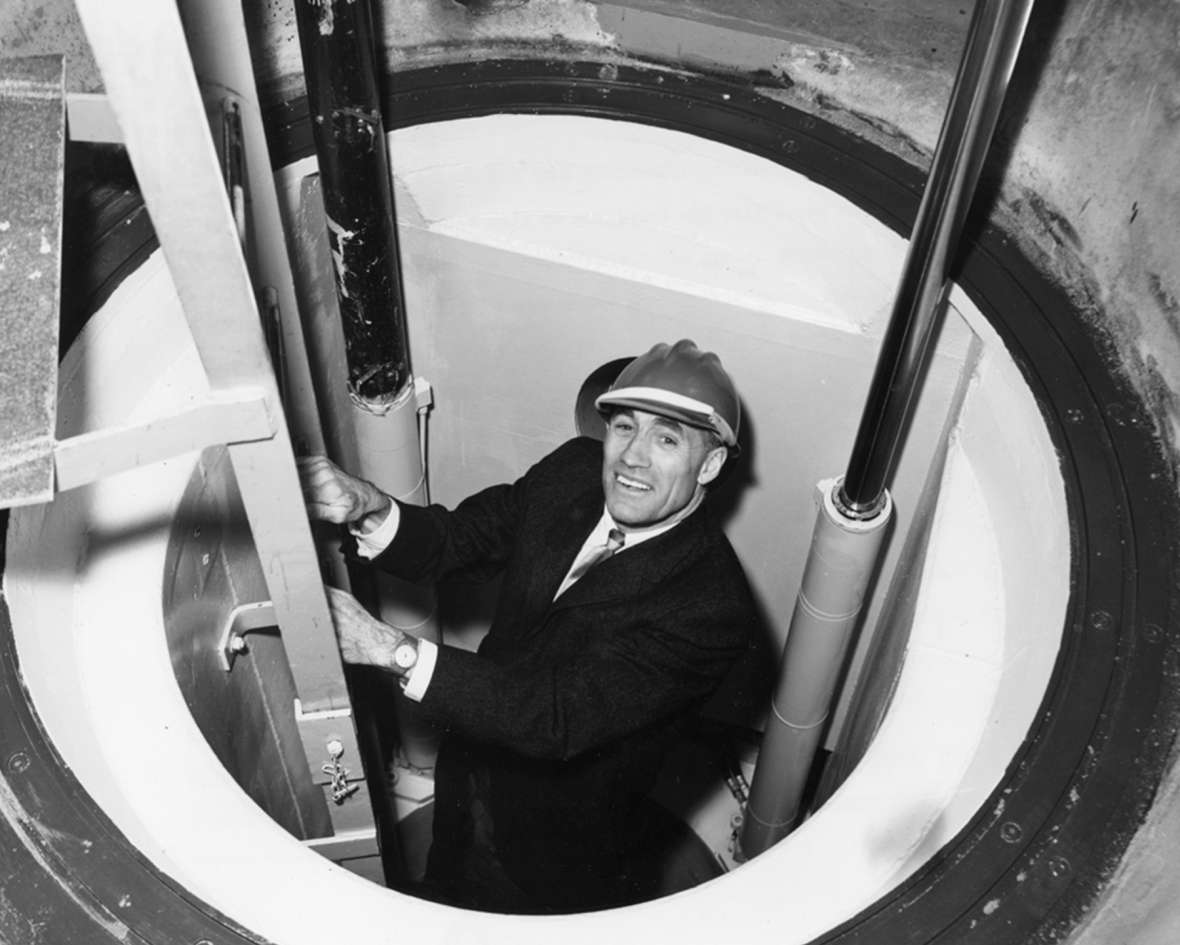
Atlas missiles
The first missile squadron deployment of Atlas missiles was established at F.E. Warren in 1960. The missiles were scattered in the ranching country across southeast Wyoming, western Nebraska and northeastern Colorado.
Between 1963 and 1965, the Atlas missiles were phased out and replaced by Minuteman I missiles, and later by Minuteman IIIs between 1972 and 1975.
The deployment of the first 24 Atlas missiles did not create much controversy in Cheyenne. The base has always been considered a good neighbor in southeastern Wyoming, and the missiles and the federal spending that came with them provided an important economic boost in an era of decline for the state. Between 1959 and 1965, more than 50,000 people migrated out of Wyoming, a population loss that was offset by an excess of births over deaths. Things would have been worse if it weren’t for the influx of money, military personnel and their families that together developed the base into a major center for intercontinental missiles. (Larson)
The Atlas missiles were no sooner installed than they began to be dismantled for the more advanced Minuteman missile. By 1963, Warren controlled 200 Minuteman 1B missiles, scattered in silos across the plains of southeast Wyoming, southwest Nebraska, and northeast Colorado. Each missile carried one thermonuclear warhead, capable of delivering an explosive force — known as “throw weight” — of about 1.2 megatons. The bomb that destroyed Hiroshima was estimate at 15 kilotons. So a single Minuteman warhead packed the power of nearly 100 Hiroshima bombs.
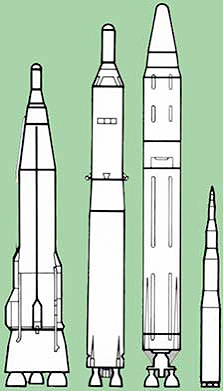
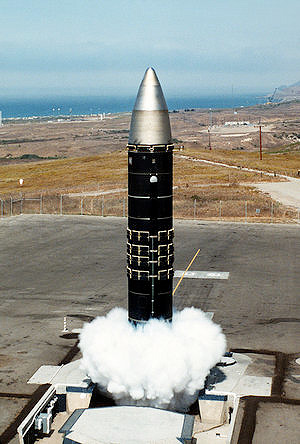
|
Minuteman missiles
The first Minuteman missiles at Warren were wonders of the age, potentially able to deliver their bombs within half a mile of their target after traveling thousands of miles through atmosphere and space. They carried the first recognizably modern on-board computer guidance systems. The tactics for strategic nuclear weapons gradually diverged between the U.S. and the U.S.S.R. American forces went for smaller “throw weight” that could be delivered more accurately, while the Soviets built larger bombs. A “most likely” Soviet weapon was believed to be a 25-megaton warhead. Most U.S. nuclear weapons were between one-third and one megaton, but even the smallest of these had ten times more explosive power than the Hiroshima bomb.
The missiles were placed in silos, the bottom of which are about 170 feet below the ground surface. One of the problems with the Minuteman was that the military could not be absolutely sure they would work when fired from a silo. “Twice a year,” said the site activations task force commander at F.E. Warren in 1983, “one of the missiles — we never know which one — is pulled from its silo and test fired at Vandenburg Air Force Base in California. Our success rate is very good.” (Whipple 1983) But the Vandenburg launches then and now are from above-ground test launch facilities. One critic noted that a Minuteman has never actually been successfully launched from an operational silo. The Air Force tried to do it four times, then gave up (Fallows).
The MX
In November 1982, meanwhile, then-President Ronald Reagan announced in November of that year that he planned to deploy 100 new MX missiles in hardened silos in the ranching country of southeast Wyoming.
The MX was the pinnacle of Cold War land-based nuclear weaponry. It was a “multiple independently targetable re-entry vehicle” (MIRV) with ten nuclear warheads that could be dropped within a 120-meter radius of their target. Each warhead carried about a third of a megaton of explosive power.
According to the Scowcroft Commission, established in January 1983 to study the nation’s strategic modernization needs, the MX “is a four-stage intercontinental ballistic missile capable of delivering up to ten independently targeted and highly accurate nuclear warheads. The missile is approximately 71 feet long, 92 inches in diameter and weighs 195,000 pounds…
“In contrast, the Minuteman III missile is 60 feet long with a first stage diameter of 66 inches and weighs 78,000 pounds.” (FEIS 1984).
Racetrack, rails and dense packs
The MX’s journey to Cheyenne was a circuitous one. The Carter administration in 1979 authorized the study of a basing system called the “racetrack.” This was a plan by which the 200 nuclear missiles would be loaded on trucks and shuffled around a large road network—which would have to be built new—networked through much of Utah and a large part of Nevada. Along the new roads the Air Force would also build 4,600 concrete shelters from which the missiles could be launched.
On word of an attack by the Soviets, the missile-laden trucks would rumble off to these launchers, so the Soviets wouldn’t know which ones were occupied and which ones were not. The hypothesis was that in the confusion at least some of the missiles would survive an initial attack, remaining available for a counterstrike.
This plan was intended to solve one of the biggest problems in nuclear-war fighting strategy, the issue of “survivability” of a retaliatory force in the face of a first strike. Land-based missiles were only one leg of the response triad—submarine-based and bomber-launched missiles are the other two.
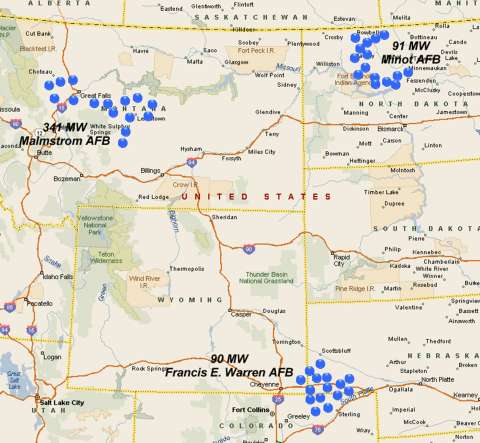
The racetrack system idea was abandoned in 1982. The final blow to the idea was the opposition of the Church of Jesus Christ of Latter-day Saints in Salt Lake City. The Mormon Church formally opposed the racetrack-basing scheme on May 5, 1981. In a strongly worded Christmas message in 1980, the church had been highly critical of the arms race. (Cooke)
The racetrack system was abandoned in favor of a “rail garrison” basing system, essentially the same principle as the racetrack, except the missiles would be placed on rail cars and shuttled around the commercial rail system in times of increased Cold War tensions to try to assure survivability. The rail garrison system was never implemented either, but it had been slated to be headquartered at F.E. Warren.
The upshot was that the Air Force abandoned the “racetrack” for the “dense pack.” Public criticism by then becoming more strident, opponents dubbed the new idea the “dunce pack.” Formally called “closely spaced basing,” the idea was that concentrating MX missiles in a small area in hardened silos would require that an enemy launch several missiles to destroy them. The incoming missiles would explode, destroying each other rather than their target—or, at least, not destroying all of the targets.
Air Force Capt. Patrick Mullaney, director of public affairs for the Ballistic Missile Office in 1983, said, “The silos encapsulate concrete in strongly confined steel. In the past, 45,000 to 50,000 pounds of pressure per square inch would destroy concrete. However, with the steel, the concrete silos have survived the tests.” They were also located 170 feet underground.
Mullaney added that missile fratricide “is well understood. That is not really in doubt. There are some very simplistic arguments against it. We’re very confident that a large percentage of the system will be survivable.”
Despite this confidence, other observers were less sanguine about dense pack. Congress moved very slowly to approve the MX in part because of concerns about the survivability issue.
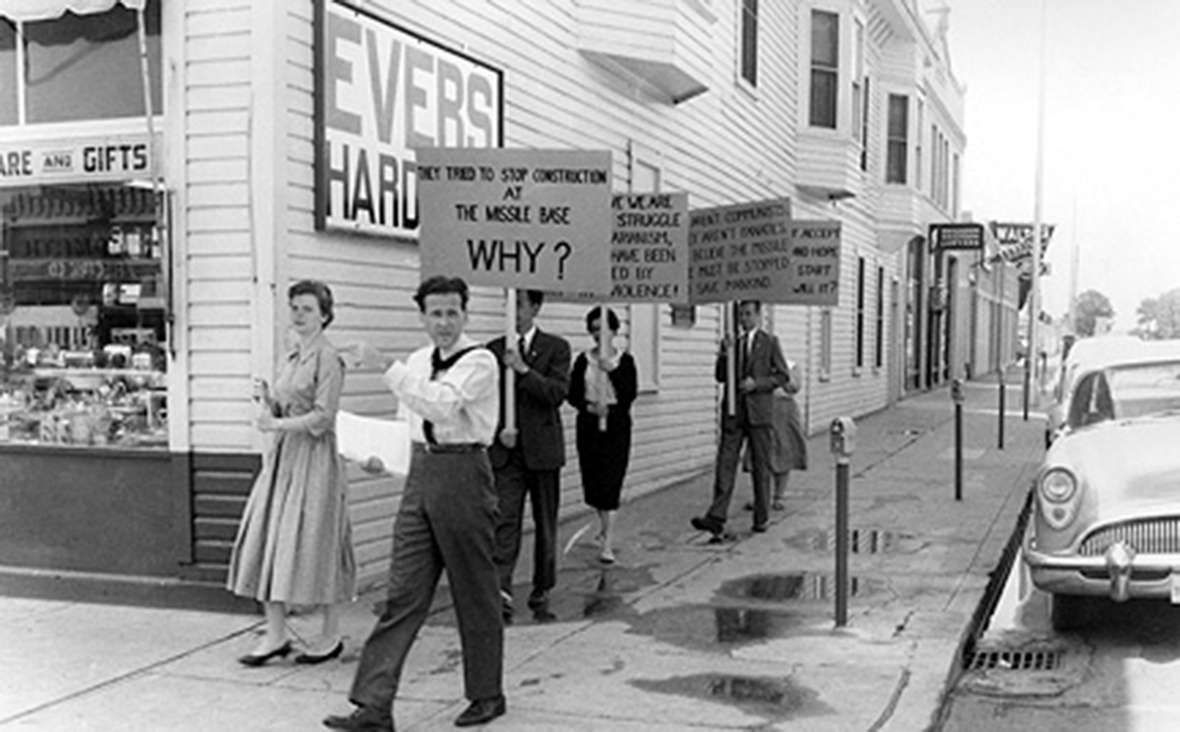
Protests
Reagan’s announcement on putting the MX in Cheyenne brought some protests from local residents, though the outcry was not widespread. The Tri-State MX Coalition was organized by Sister Frances Russell, a Roman Catholic Sister of Charity in Cheyenne. Cheyenne Archbishop Joseph Hart issued a letter opposing the MX. The Rocky Mountain Farmers Union passed resolutions opposing the MX and in favor of a nuclear weapons freeze. The Reagan administration, meanwhile, began calling the MX the “Peacekeeper.” But the name never really caught on outside of official publications.
Not everyone in Cheyenne favored the siting of missiles nearby, as is clear from the August 1958 photo above of protesters in Cheyenne. Several ranchers near Cheyenne who had missile silos on their property later came out in opposition to the MX. One family, the Kirkbrides, had silos on their property from the 1960s on. Lindi Kirkbride opposed the siting of the MX, however, saying, “There’s a qualitative difference between the MX and the Minuteman III ... It is an offensive weapon as opposed to a defensive one.”
Wyoming’s Congressional delegation—which at the time consisted of Republicans Sen. Malcolm Wallop and Sen. Alan Simpson, and Rep. Dick Cheney—kept quiet on the subject. They didn’t push to have the MX placed in Cheyenne, but neither did they oppose it.
Image

In December 1986, 10 MX missiles were placed in existing Minuteman silos under the command of F.E. Warren’s 90th Strategic Missile Wing. Full operational capability was achieved in December of 1988 with a total of 50 MX missiles. Congress had cancelled the planned deployment of 100 missiles in 1985, primarily because of concerns over the survivability question.
Safety problems
The Air Force had given substantial reassurances that the missile operations were safe, and that there was little chance of an accident or accidental launch. There was theoretically a one in 10 million chance of an accidental launch of a missile. But events at F.E. Warren soon called this statistic into question.
In 1984, there was an incident at Warren that was nearly funny—except for the nuclear weapons involved. A computer malfunction caused an indication that a missile was about to launch itself from a silo. An armored vehicle was rolled onto the silo cover to prevent the accident. (Gregory and Edwards 1988)
Then on June 15, 1988, only 15 months after it had been sited, an MX missile collapsed in silo Q-10 on the Wyoming plains, setting off a “missile away” indicator in the control room. A “missile away” light would indicate that a missile had been launched in a proper launch sequence. The “missile away” served a second function as well. In most cases—well in every case so far—the light is simply a warning light that indicates a problem with the missile for which maintenance is necessary.
And the “missile away” warning protocols note that there should be no attempt to restore power to the missile—a stricture that was violated in this case. The accident spurred an improper and potentially dangerous attempt to restore power to the missile, which could have led to disaster.
The skirt at the base of the missile had collapsed, the result of a failed epoxy bond. It dropped six to eight inches within the silo. The event set off warning lights, initiating a series of steps that could have triggered an accidental launch in a closed silo. In such a case, there would not have been a nuclear explosion, but the fuels and other non-nuclear parts could have blown up, contaminating the silo and the surrounding area with intense nuclear radiation.
Capt. James T. Bush, USN (ret.) was at the time associate director for the Center for Defense Information. Asked in a newspaper interview to put a probability on the possibility of an accidental launch under the conditions at Q-10, Bush replied, “I’d say the likelihood is still pretty low, probably one in a hundred. But you know there are Air Force requirements for safety circuits to have a one in 10 million [chance] against an accidental launch … Certainly if you’ve got a rupture in that portion of the missile that has the rocket fuel in it, you’ve got yourself a pretty dangerous situation.” (Whipple 1989)
The risk from the accident at Q-10 was compounded when technicians violated the safety protocols. According to testimony at an Air Force hearing, the transcript of which was obtained under a Freedom of Information Act request, the “missile away” warning light is supposed to forestall a startup attempt. But that information wasn’t given to technicians, who then attempted to restore power to the missile. This created the small but very real possibility of an electrostatic discharge igniting the rocket fuel.
In the end, not much happened. The incident called into question the Air Force’s safety data to the extent that the Colorado attorney general’s office sued the federal government, eventually requiring a rewriting of part of the MX environmental impact statement to reflect the new information.
The waning of the Cold War reduced the need for overwhelming nuclear deterrence and for the MX. The missiles were eventually retired and moved to duty as satellite launchers. The last MX missiles were decommissioned in September of 2005. Warren AFB currently commands 150 Minuteman III missiles as its main operational mission.
Still, safety questions continue to plague the Air Force’s handling of nuclear missiles at Warren and elsewhere. In 2008, Secretary of the Air Force Michael Wynne and Air Force Chief of Staff General T. Michael Moseley, were fired over a 2007 incident at a North Dakota air base in which nuclear-armed missiles were inadvertently shipped via plane to a base in Louisiana. The nukes were supposed to have been removed prior to sending the missiles.
And in October 2010, a hardware failure at F.E. Warren took 50 of the base’s 150 Minuteman missiles temporarily offline. This incident was similar to another that had occurred in 1998 at North Dakota’s Minot AFB and Montana’s Malmstrom AFB. But apparently word of the problem had not been communicated to F.E. Warren.
The last failure caused Wyoming Republican Sen. John Barrasso to call for the nation to maintain more nuclear weapons than were at the time contemplated under the most recent version of the U.S.-Russian Strategic Arms Reduction Talks (START) being considered for ratification by the Senate in the wake of agreements on language reached by U.S. and Russian negotiators in the spring of 2010.
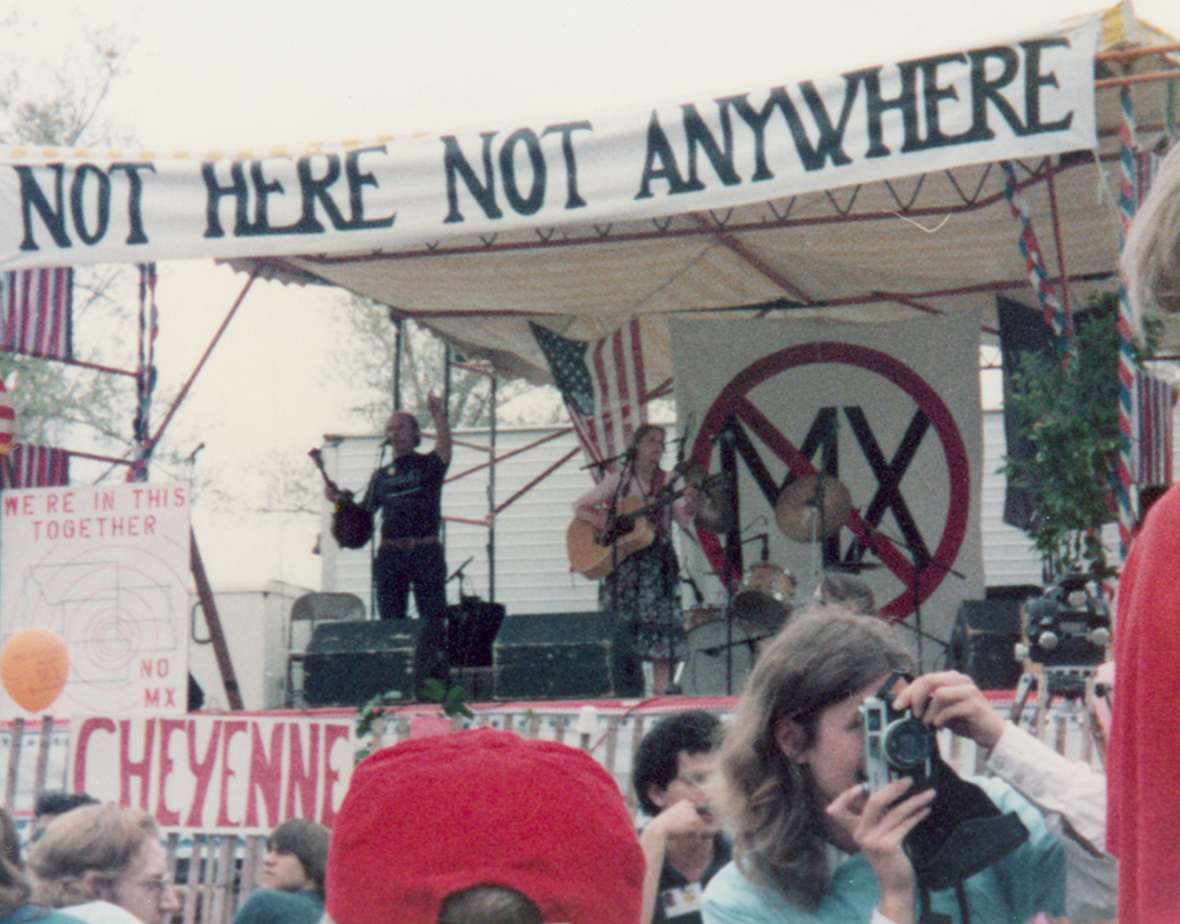
START
"The recent failure reinforces the need for the United States to maintain 450 ICBMs to ensure a strong nuclear defense," Barrasso said late in October 2010. "If new START had been in place on [the day of the failure], we would have immediately been below an acceptable level to deter threats from our enemies. Before ratifying this treaty, the Senate must ensure we modernize our own nuclear weapons and strengthen our national security."
The new START treaty allows the U.S. to retain a maximum of 1,550 nuclear warheads on alert, a total that includes the warheads on the 450 ICBMs Barrasso alluded to. Other warheads are on bombs carried by aircraft, and on missiles on submarines. Air-, sea-, and land-based missiles make up the so-called nuclear triad.
The number of warheads and missiles allowed by START has important implications for the future of F.E. Warren Air Force Base, particularly as Warren’s mission is confined solely to the support of land-based ICBMs.
The new START was signed in April 2010 by Russia and the United States and went into effect on Feb. 5, 2011.
In November 2018, Barrasso, Wyoming Sen. Mike Enzi, and 22 other U.S. Senators, all Republicans, wrote a letter asking President Trump “to consider the key factors that underpin the continued viability” of the new treaty, Barrasso announced in a press release. Those key factors include a “sustained and vigorous U.S. nuclear weapons modernization program, strict compliance by Russia” with its obligations and a “true balance of nuclear capabilities” between the two nations. The senators wrote that they also support funding for modernization of nuclear weapons and a “rigorous review of the continued viability” of the New START.
The press release also noted that F.E. Warren Air Force Base is scheduled to get new missiles “to replace the older Minuteman III missiles as a result of U.S. nuclear modernization.” No date for the timing of this replacement was mentioned
Resources
Primary Sources
- Ambinder, Marc. “Failure Shuts Down Squadron of Nuclear Missiles,” The Atlantic online, October 26, 2010, accessed Nov. 15, 2010, http://www.theatlantic.com/politics/archive/2010/10/power-failure-shuts-down-squadron-of-nuclear-missiles/65207/
- Ambinder, Marc. “Nuclear Fail: Is START in Trouble?” The Atlantic online, October 28, 2010, accessed Nov. 15, 2010, http://www.theatlantic.com/politics/archive/2010/10/nuclear-fail-is-start-in-trouble/65265/
- Cooke, Brec. “Shellacking the shell game in the Great Basin.” High Country News. December 10, 1982. Vol. 14: 24.
- FEIS. Final Environmental Impact Statement. Peacekeeper in Minuteman Silos. Vol. 1, January 1984. 90th Strategic Missile Wing, F.E. Warren AFB.
- Whipple, Dan. “All MXed up in Cheyenne.” High Country News. December 10, 1982. Vol.14: 24.
- Whipple, Dan. “Missiles, men and Armageddon.” High Country News. August 5, 1983. Vol. 13: 15.
- Whipple, Dan. 1989. “MX missile silo collapse examined in Air Force investigation report.” Casper Star-Tribune. May 21, 1989.
- “Wyoming Senators Urge President Trump to Consider Key Factors in Review of U.S.-Russian Treaty,” John Barrasso, U.S. Senator, Wyoming, Nov. 29, 2018. Accessed Jan. 7, 2019, at https://www.barrasso.senate.gov/public/index.cfm/2018/11/wyo-senators-urge-president-trump-to-consider-key-factors-in-review-of-u-s-russian-nuclear-treaty.
Secondary Sources
- Fallows, James. National Defense. (New York: Random House, 1981).
- Gregory, Shaun and Alistair Edwards. A Handbook of Nuclear Weapons Accidents. (Bradford, U.K.: School of Peace Studies, University of Bradford, 1988).
- Goodby, James E. At the Borderline of Armageddon: How American Presidents Managed the Atom Bomb. (Lanham, MD: Rowan & Littlefield, 2006), 43.
- Holland, Maj. Stephen. From Mules to Missiles: A History of F.E. Warren Air Force Base and It’s Predecessors Fort D.A. Russell and Fort F.E. Warren. (Cheynne: Warren AFB, February 1983, revised March 1987).
- Larson, T.A. History of Wyoming. (Lincoln: University of Nebraska Press, 1990).
- Neufeld, Jacob. 1990. in The Development of Ballistic Missiles in the United States Air Force, 1945-1960. (Washington, D.C.: Office of Air Force History, 1990). For Convair contract details and the Air Force role in developing missiles.
- “New START at a Glance,” Arms Control Association. Accessed Jan.7, 2019 at https://www.armscontrol.org/factsheets/NewSTART.
- Radiation Effects Foundation on http://www.rerf.or.jp/general/qa_e/qa1.html
- U.S. Air Force Fact Sheet. “F.E. Warren History” accessed Nov. 12, 2010, http://www.warren.af.mil/library/factsheets/factsheet.asp?id=4696
- White, Phil, Jr. Wyoming in Mid-Century: Prejudice, Protest and the "Black 14." Self-published 2019. Available on Amazon.com. Includes a chapter on the protests and civil disobedience at the early Atlas missile sites in the summer of 1958.
For further reading and research
- “Command and Control,” American Experience, PBS. Air date April 25, 2017. Accessed Feb. 26, 2019 at https://www.pbs.org/wgbh/americanexperience/films/command-and-control/. This chilling documentary examines a deadly nuclear missile accident that occurred in Arkansas in 1980.
- Tupper, Seth. “Details of South Dakota Nuclear-Missile Accident Released,” Rapid City Journal via Associated Press. Air Force Times.Nov. 4, 2017. Accessed Nov. 14, 2018, at https://www.airforcetimes.com/news/2017/11/04/details-of-south-dakota-nuclear-missile-accident-released/.
- “Ground Zero, Wyoming.” 29-minute Main Street, Wyoming documentary, Wyoming PBS. First aired July 28, 2008. Accessed March 8, 2019 at https://video.wyomingpbs.org/video/main-street-wyoming-ground-zero-wyoming/. Highlights the role that missiles based at F.E. Warren AFB played both early and late in the Cold War, and includes footage of early Atlas and Minuteman missiles, scenes of anti-MX protests and interviews with Air Force personnel, local government officials and the ranching Kirkbride family
Illustrations
- The photos of the Warren front gate, the 1952 H-bomb test, Sen. Wallop and Simpson and Rep. Cheney are from Google Images.
- The photo of General Pershing’s house is from Wikipedia’s entry on Warren AFB.
- The graphic of Atlas, Titan, and Minuteman missiles is from a National Park Service history of Minuteman missile sites accessed Nov. 12, 2010, http://www.nps.gov/archive/mimi/history/srs/history.htm.
- The photo of the abandoned Atlas launch facility is by Hans Hansen/Photonica/Getty Images; see http://www.gettyimages.com/?esource=googUSA_Brand_Terms&language=en-us&kw=USA+getty_images+broad
- The image of the launching MX is from “Nuclear Missile Silo” entry at Statemaster.com. accessed Nov. 12, 2010 at http://www.statemaster.com/encyclopedia/Nuclear-missile-silo,
- The map of missile sites in the West and the image of F.E. Warren behind the missiles are USAF graphics.
- The photo of the protesters in Cheyenne is by longtime Wyoming Eagle photographer Francis S. Brammar, from the Brammar collection in the Wyoming State Archives.
